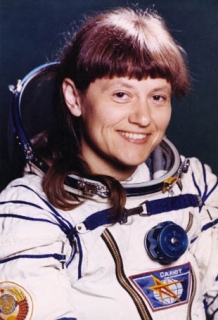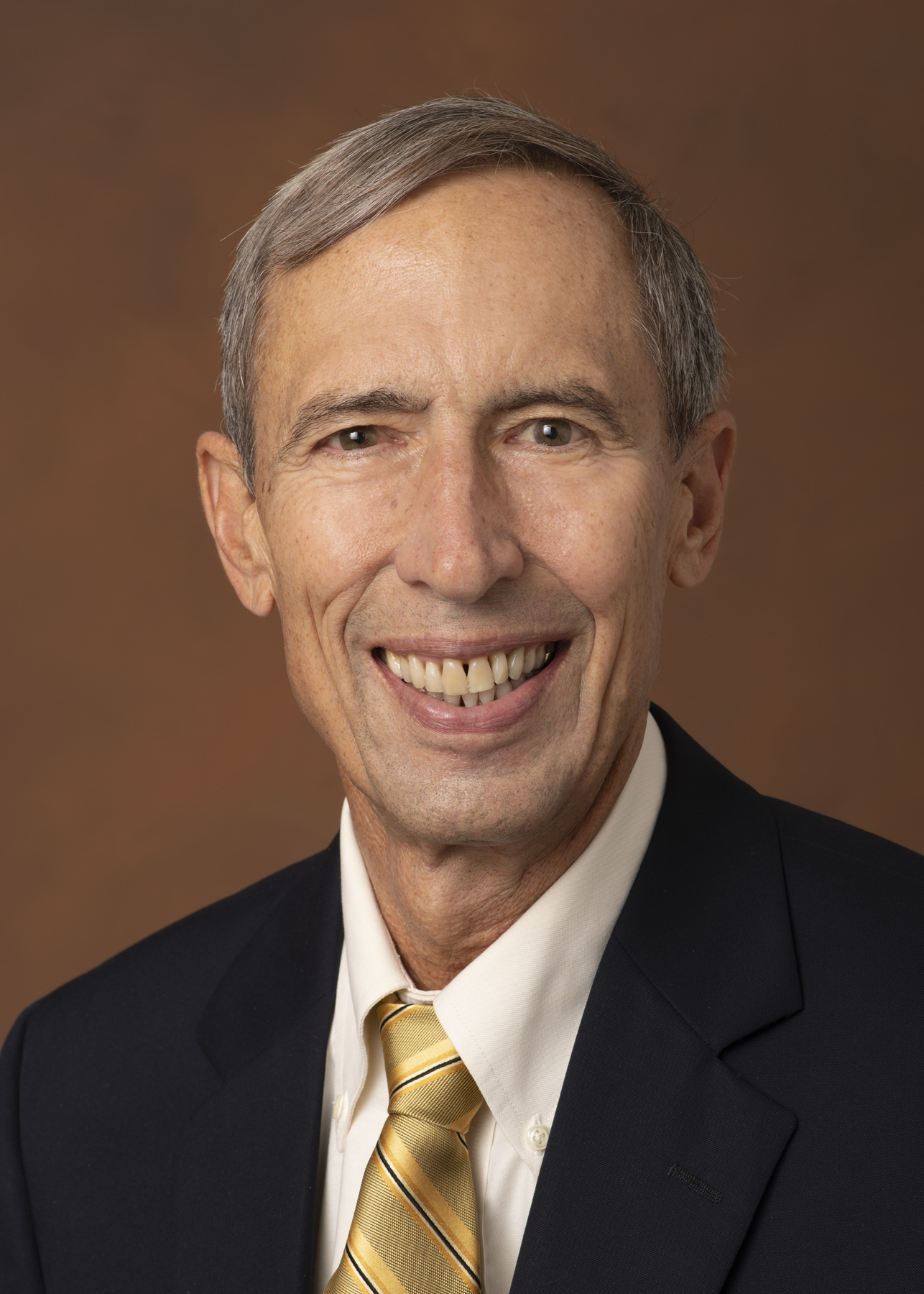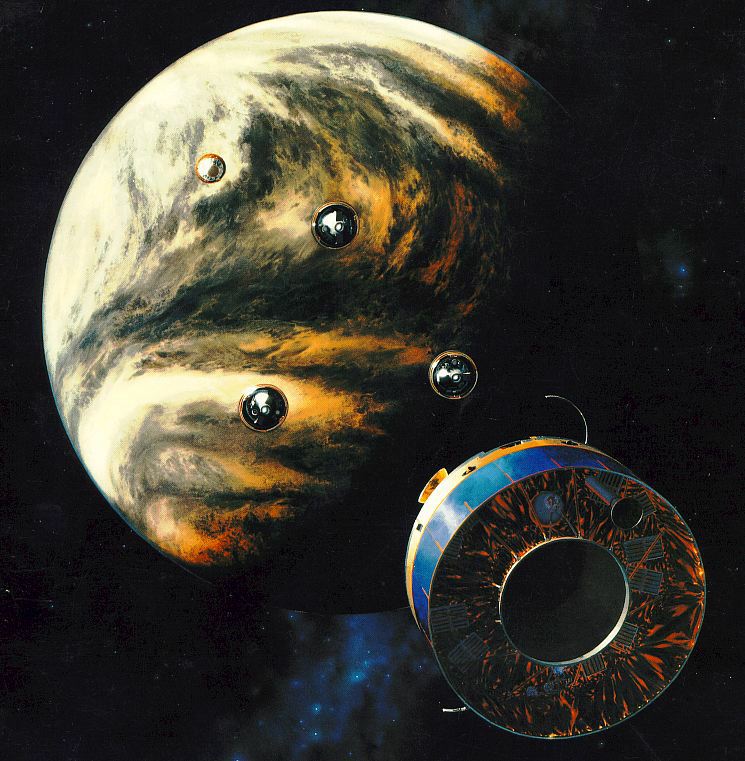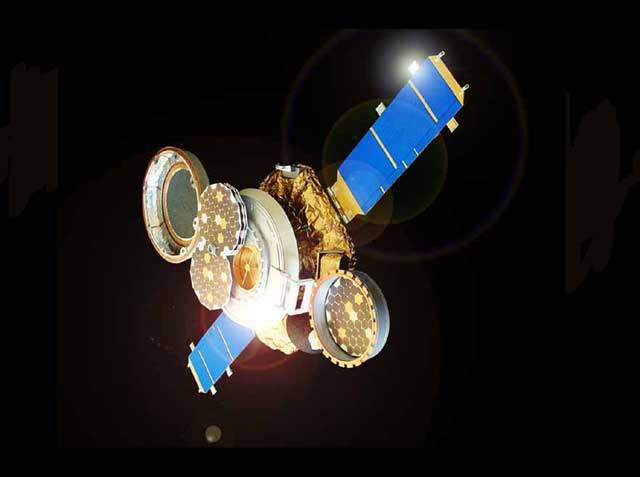If you are not already a subscriber, you are welcome to enter your email address here to sign up to receive the Space History newsletter on a daily basis. Under no circumstances will we release your legitimate email address entered here to outside persons or organizations, and it will only be used for mailing the specific information you have requested.
| Enter your email address here: |
Unsubscribe instructions are included in every newsletter issue in case you decide you no longer wish to receive it.
Note: We record the IP address from which subscriptions are entered to help prevent SPAM abuses.
Race To Space
Someone will win the prize...
... but at what cost?
Visit RaceToSpaceProject.com
to find out more!
1579
The cornerstone was laid for Tycho Brahe's Uraniborg observatory.
ref: en.wikipedia.org
1709
The first known ascent in a hot-air balloon, by Bartolomeu de Gusmao, took place, indoors.
ref: en.wikipedia.org
1864
Comet C/1864 N1 (Tempel) approached within 0.0964 AUs of Earth (approx. 8.9 million miles, 14 million km), the 23rd closest known approach by a comet in recorded history.
ref: cneos.jpl.nasa.gov
1901
Born, Ernest O. Lawrence, US physicist, inventor (Cyclotron, Nobel 1939 "for the invention and development of the cyclotron and for results obtained with it, especially with regard to artificial radioactive elements")
ref: www.nobelprize.org
1902
Born, Paul A. M. Dirac, English physicist (quantum mechanics, Nobel 1933 with Schrodinger "for the discovery of new productive forms of atomic theory")
Paul Adrien Maurice Dirac, (8 August 1902 - 20 October 1984) was a British theoretical physicist and a founder of the field of quantum physics.
Dirac studied electrical engineering at the University of Bristol, completing his degree in 1921. After working briefly as an engineer, Dirac decided that his true calling lay in the mathematical sciences. He completed a degree in mathematics at Bristol in 1923 and then received a grant to conduct research at St. John's College, Cambridge, where he would remain for most of his career. At Cambridge he became interested in the general theory of relativity and in the nascent field of quantum physics, and worked under the supervision of Ralph Fowler.
In 1926 he developed a version of quantum mechanics that incorporated the previous work of Werner Heisenberg on "Matrix Mechanics" and of Erwin Schrodinger on "Wave Mechanics" into a single mathematical formalism that associates measurable quantities with operators acting on the Hilbert space of vectors that describe the state of a physical system. For this seminal work he was awarded a Ph.D. from Cambridge.
In 1928, building on Pauli's work on nonrelativistic spin systems, he derived the Dirac equation, a relativistic equation describing the electron. This work led Dirac to predict the existence of the positron, the electron's antiparticle, which he interpreted in terms of what came to be called the Dirac sea. The positron was subsequently observed by Carl Anderson in 1932. Dirac also contributed to explaining the origin of quantum spin as a relativistic phenomenon.
ref: www.nobelprize.org
1907
A. Kopff discovered asteroid #3105.
1909
A. Kopff discovered asteroid #684 Hildburg.
1921
K. Reinmuth discovered asteroid #956 Elisa.
1923
S. Belyavskij discovered asteroid #1001 Gaussia.
1929
P. Parchomenko discovered asteroid #1129 Neujmina.
1931
H. Van Gent discovered asteroid #1946.
1932
K. Reinmuth discovered asteroid #1256 Normannia, #1257 Mora, #1258 Sicilia and #1273 Helma.
1940
Born, Dennis Tito (at New York, New York, USA), American cosmonaut (Soyuz TM-32/ISS EP-1/Soyuz TM-31; over 7d 22h in spaceflight), first space tourist

Dennis Tito, the first private citizen to visit the International Space Station, shares his experiences at the 40th Space Congress
NASA photo KSC-03pd1489 (30 April 2003)
ref: en.wikipedia.org
1946
Born, Andrea Lorenzoni (at La Maddalena, Italy), ISS Program manager for Node 2, Italian Space Agency (ASI), payload specialist astronaut candidate (inactive)
ref: www.spacefacts.de
1948
Born, Svetlana Yevgenyevna Savitskaya (at Moscow, Russian SFSR), Soviet cosmonaut (Salyut 7, Soyuz T-12; over 19d 17h total time in spaceflight), second woman in space, first woman to walk in space

Cosmonaut Svetlana Savitskaya
Source: thisdayinaviation.com
Soviet cosmonaut Svetlana Yevgenyevna Savitskaya (8 August 1948 - ) was the first woman to walk in space, on 25 July 1984, aboard the Soyuz T-12 (launched 17 July 1984). Her spacewalk lasted 3.58 hours. Savitskaya was also the second woman to go into space (aboard Soyuz T-7, launched 19 August 1982), and the first woman to go to space twice (1982 and 1984).
ref: www.spacefacts.de
1956
Born, Larry Dean James (at Bristol, Virginia, USA), deputy director of NASA's Jet Propulsion Laboratory, astronaut candidate (DoD Group 2 - 1982)

Larry D. James, JPL Deputy Director, NASA photo
ref: www.jpl.nasa.gov
1962 18:08:00 GMT
NASA and the USAF launched X-15A Heating, aero drag Test mission # 66 in which Robert Rushworth reached a maximum speed of 2943 mph (4736 kph, Mach 4.40), and attained a maximum altitude of 90,875 ft (27.699 km, 17.211 mi).
ref: en.wikipedia.org
1968 20:12:00 GMT
A Scout B rocket launched from Vandenberg, California, carried 2 satellites to orbit, Explorer 39 (Air Density Explorer) to collect atmospheric density and temperature data, and Explorer 40 (Injun Explorer) to collect radiation data.
ref: nssdc.gsfc.nasa.gov
1977
The USSR Salyut 5 research laboratory was de-orbited and destroyed during re-entry into the Earth's atmosphere.
Salyut 5, launched 22 June 1976, was the second successful flight of the USSR Almaz manned military space station. Structurally similar to Salyut 3, it had a total mass of approximately 18-19 tons. It had two solar panels laterally mounted on the center of the station, and a detachable recovery module, for the return of research data and materials. Tracking ships with Academician Sergei Korolev and Cosmonaut Yuri Gagarin were stationed in the Atlantic and Caribean to provide communications when out of tracking range of the USSR. Salyut 5 operated for 409 days, during which the crews of Soyuz 22 (7 July - 24 August 1976) and 24 (8 February 8 - 25 February 1977) visited the station. Soyuz 23 was also to have docked (15 October 1976), but its long distance rendezvous system failed. Soyuz 25 was planned, but the mission would have been incomplete due to low orientation fuel on Salyut 5, so it was cancelled.
During the flight of Salyut 5 a "parallel crew" worked in a duplicate station on the ground. They conducted the same operations in support of over 300 astrophysical, geophysical, technological, and medical/biological experiments. Astrophysics studies included an infrared telescope-spectrometer in the 2-15 micrometer range, which also obtained solar spectra. Earth resources studies were conducted as well as Kristall, Potok, Diffuziya, Sfera, and Reatsiya technology experiments. Presumably Salyut 5 was equipped with a SAR side-looking radar for reconnaissance of land and sea targets even through cloud cover.
The film capsule was ejected 22 February 1977, the station was deorbited on 8 August 1977. In addition to the human crew, two Russian tortoises (Testudo horsfieldi) and Zebrafish (Danio rerio) were flown.
The results of the Salyut 3 and 5 flights showed that manned reconnaissance was not worth the expense. There was minimal time to operate the equipment after the crew took the necessary time for maintenance of station housekeeping and environmental control systems. The experiments themselves showed good results, especially the value of reconnaissance of the same location in many different spectral bands and parts of the electromagnetic spectrum.
ref: nssdc.gsfc.nasa.gov
1978
N. Chernykh discovered asteroids #2431 Skovoroda, #2626 Belnika, #2627 Churyumov, #2794 Kulik, #2916 Voronveliya, #3027 Shavarsh, #3195 and #3599.
1978 07:33:00 GMT
NASA launched Pioneer 13 (Pioneer Venus 2) from Cape Canaveral, Florida, towards its 9 December 1978 rendesvous with Venus.

Pioneer Venus 2 releasing its probes for descent into the Venusian atmosphere, NASA illustration
Source: NSSDCA Master Catalog
Pioneer 13, the Pioneer Venus Multiprobe mission, was launched 8 August 1978. On this mission, four instrumented atmospheric entry probes were carried by the spacecraft bus to the vicinity of Venus and released for descent through the atmosphere to the planetary surface. Two small probes entered on the night side, and one small probe and the large probe entered on the day side of the planet. During the 123 day trip to Venus, the large probe was released 16 November 1978, and the three small probes on 20 November. All four probes entered the Venusian atmosphere on 9 December, followed by the bus. The large probe took 1.5 hours to descend through the atmosphere, while the three smaller probes reached the surface of the planet 75 minutes after entry. The bus portion of the spacecraft was targeted to enter the Venusian atmosphere at a shallow entry angle and transmit data to Earth until it was destroyed by the heat of atmospheric friction during its descent. Investigators emphasized the study of the structure and composition of the atmosphere down to the surface, the nature and composition of the clouds, the radiation field and energy exchange in the lower atmosphere, and local information on the atmospheric circulation pattern. Simultaneous measurements by the probes and the Pioneer Venus Orbiter permitted relating specific local measurements to the general state of the planet and its environment as observed from orbit. The probes stopped transmitting temperature data about 15 km above the surface of Venus, but two probes survived on the surface and transmitted other data for a matter of seconds to minutes. The bus ceased transmitting data at an altitude of about 165 km.
ref: nssdc.gsfc.nasa.gov
1978 22:31:22 GMT
USSR launched the unmanned supply vessel Progress 3 from Baikonur for delivery of fuel, consumable materials and equipment to the Salyut 6 space station.
USSR launched the unmanned supply vessel Progress 3 on 8 August 1978 for delivery of fuel, consumable materials and equipment to the Salyut 6 space station. Progress 3 docked with Salyut 6 on 9 Aug 1978 at 23:59:30 GMT, undocked on 21 Aug 1978 at 15:42:50 GMT, and was destroyed in reentry on 23 Aug 1978 at 16:45:00 GMT. Total free-flight time 4.10 days. Total docked time 11.66 days.
ref: nssdc.gsfc.nasa.gov
1980
E. Bowell discovered asteroids #2597 Arthur, #3350 Scobee, #3488 Brahic and #3559 Violamayer.
1983
E. F. Helin discovered asteroid #3737.
1984
During the 5h 00m Salyut 7 EO-3-6 EVA, cosmonauts Kizim and Solovyov repaired the Salyut 7 propulsion system fuel lines.
ref: www.spacefacts.de
1984 12:08:00 GMT
USSR launched the Cosmos 1589 geodetic satellite from Plesetsk for investigation of the upper atmosphere and outer space.
ref: nssdc.gsfc.nasa.gov
1985 21:01:00 GMT
USSR launched Raduga 16 from Baikonur for telephone/telegraph communication and television broadcasting, positioned in geosynchronous orbit at 45 deg E 1985-1987; 170 deg W 1987-1988.
ref: nssdc.gsfc.nasa.gov
1988
Discovery of the galaxy known as most distant at the time (15 billion light years) was announced.
ref: apnews.com
1989 08:37:00 EDT (GMT -4:00:00)
NASA launched STS 28 (Columbia 8, Shuttle 30), the fourth Department of Defense (DoD) Shuttle mission.
STS 28 was launched 8 August 1989. Liftoff occurred during a classified launch window lying within the launch period extending from 7:30 AM to 11:30 AM EDT.
STS 28 was the fourth Shuttle mission dedicated to the Department of Defense, and the first flight of Columbia since Mission 61-C.
STS 28 ended 13 August 1989 when Columbia landed on revolution 81 on Runway 17, Edwards Air Force Base, California. Rollout distance: 6,015 feet. Rollout time: 47 seconds. Launch weight: Classified. Landing weight: 190,956 pounds. Orbit altitude: Classified. Orbit inclination: 57 degrees. Mission duration: five days, one hour, zero minutes, eight seconds. Miles traveled: 2.1 million. The orbiter was returned to the Kennedy Space Center on 21 August 1989.
The flight crew for STS 28 was: Brewster H. Shaw, Jr., Commander; Richard N. Richards, Pilot; James C. Adamson, Mission Specialist 1; David C. Leestma, Mission Specialist 2; Mark N. Brown, Mission Specialist 3.
ref: www.nasa.gov
1989 23:25:53 GMT
An Ariane 44LP launched from Kourou lofted two satellites into space, Germany's direct broadcast TV Sat 2, initially positioned in geosynchronous orbit at 19 deg W, and Europe's Hipparcos astronomy satellite, which didn't reach GEO due to an AKM failure.
ref: nssdc.gsfc.nasa.gov
1991
Died (heart attack, age 61), James Benson Irwin, Colonel USAF, NASA astronaut (Apollo 15; nearly 12d 7.25h in spaceflight), eighth person to walk on the Moon
ref: en.wikipedia.org
1991
The Warsaw radio mast collapsed, which had been the tallest construction in the world at the time.
ref: en.wikipedia.org
1992 09:11:51 EDT (GMT -4:00:00)
NASA's STS 46 (Atlantis 12, Shuttle 49) ended after carrying the TSS-1 Tethered Satellite System to space, and deploying EURECA, the European Retrievable Carrier.
STS 46 was launched 31 July 1992, its liftoff delayed 48 seconds at T-5 minutes to allow the orbiter computers to verify the orbiter auxiliary power units were ready to start.
The primary objectives of STS 46 were deployment of the European Space Agency's European Retrievable Carrier (EURECA), and operation of the joint NASA/Italian Space Agency Tethered Satellite System (TSS). The mission was extended one day to complete the science objectives. EURECA was deployed one day later than scheduled because of a problem with its data handling system. After deployment, the spacecraft's thrusters were fired to boost EURECA to its planned operating altitude of about 310 statute miles (499 kilometers). However, thruster firing was initially cut to six minutes instead of the planned 24 minutes because of unexpected attitude data from EURECA. The problem was resolved, and EURECA was boosted to its operational orbit on the sixth day of the mission. The EURECA payload would later be retrieved by STS 57 in 1993.
The TSS deployment was also delayed one day because of EURECA. During TSS deployment, the satellite reached a maximum distance of only 840 feet (256 meters) from the orbiter instead of the planned 12.5 miles (20 kilometers) because of a jammed tether line. After numerous attempts over several days to free the tether, TSS operations were curtailed, and the satellite was stowed for return to Earth.
Secondary payloads were: Evaluation of Oxygen Integration with Materials/Thermal Management Processes (EOIM-III/TEMP 2A-3); Consortium for Materials Development in Space Complex Autonomous Payload (CONCAP II and CONCAP III); IMAX Cargo Bay Camera (ICBC); Limited Duration Space Environment Candidate Materials Exposure (LDCE); Air Force Maui Optical Site (AMOS); Pituitary Growth Hormone Cell Function (PHCF); and Ultraviolet Plume Instrument (UVPI).
STS 46 ended 8 August 1992 when Atlantis landed on revolution 127 on Runway 33, Kennedy Space Center, Florida. Rollout distance: 10,860 feet (3,310 meters). Rollout time: 66 seconds. Launch weight: 256,031 pounds. Landing weight: 208,806 pounds. Orbit altitude: 230 nautical miles. Orbit inclination: 28.45 degrees. Mission duration: seven days, 23 hours, 15 minutes, three seconds. Miles traveled: 3.3 million. STS 46 was the last flight of OV-104 before its scheduled checkout and modification period, which was later extended to include modifications for docking with the Russian Mir space station; OV-104 was shipped to the Rockwell plant in California in October.
The flight crew for STS 46 was: Loren J. Shriver, Commander; Andrew M. Allen, Pilot; Jeffrey A. Hoffman, Mission Specialist 1; Franklin R. Chang-Diaz, Mission Specialist 2; Claude Nicollier, Mission Specialist 3; Marsha S. Ivins, Mission Specialist 4; Franco Malerba, Payload Specialist 1
ref: www.nasa.gov
1996 22:49:00 GMT
An Ariane 44L launched from Kourou carried Italy's Italsat F2 and France's Telecom 2D communications satellites into space, initially positioned in geosynchronous orbit at 13 deg E and 3 deg E, respectively.
ref: nssdc.gsfc.nasa.gov
2001 16:13:40 GMT
NASA launched the ill-fated Genesis solar wind sample return mission.

Genesis solar sample return probe, NASA illustration
Source: NSSDCA Master Catalog
The primary objective of the Genesis mission was to collect samples of solar wind particles and return them to Earth for detailed analysis. The science objectives were to obtain precise measurements of solar isotopic and elemental abundances and provide a reservoir of solar matter for future scientific analysis. Specifically, the primary scientific objectives were to obtain precise measurements of isotope ratios of oxygen, nitrogen, and solar wind isotopic fractionation. Study of these samples would allow testing of theories of solar system formation and evolution and early nebular composition. A total sample mass of roughly 10 to 20 micrograms was expected.
The Genesis spacecraft had a launch mass of 636 kg, including 142 kg of fuel, and consisted of a 2.3 meter long, 2 meter wide spacecraft deck with two fixed solar panel wings with a total span of 7.9 meters, and a sample return capsule mounted on top of the deck. The spacecraft was spin stabilized at one revolution every 37.5 seconds. Propulsion was provided by a hydrazine monopropellant thruster using a helium pressurant. Communication was in the S-band via a fixed antenna. The solar panels provided a maximum of 254 Watts of power to a nickle-hydrogen storage battery. Temperatures were maintained by heaters and passive thermal control. The spacecraft was also equipped with ion and electron electrostatic monitors to determine which solar wind regime was being encountered, and to help set the appropriate collector voltage. Spacecraft subsystems and monitors were mounted beneath the sample return capsule.
The sample return capsule was disc shaped with a blunt conical top and bottom, 1.5 meters in diameter and 1.31 meters high, with a total mass of about 225 kg. It contained a 97.3 cm diameter science cannister which held a concentrator and three collector arrays. The collector arrays were flat discs made of ultra-pure silicon, silicon carbide, germanium, sapphire, chemically deposited diamond, gold, aluminum, and metallic glass wafers which were exposed to the solar wind. Isotopes of helium, oxygen, nitrogen, neon, radon, and other elements were implanted in the top 100 nm of these materials. The concentrator was an electrostatic mirror which concentrated elements up to neon by a factor of approximately 20. Each collector array was to be deployed for a different solar wind regime.
Genesis was launched successfully at 16:13:40.324 UT on 8 August 2001 on a Delta 7326 (a Delta II Lite launch vehicle with three strap-on solid rocket boosters and a Star 37FM third stage). The first burn of the Delta second stage put Genesis in a 185 x 197 km x 28.5 deg parking orbit at 1624 GMT. At 1712 GMT a second burn raised the orbit to 182 x 3811 km, and at 1713 GMT the third stage fired to put Genesis on its trajectory towards the Sun-Earth L1 Lagrangian libration point, 0.01 AU from Earth, with a nominal apogee of around 1.2 million km, a three month journey. The L1 point is beyond the influences of the geomagnetic field and its trapped particles. Genesis reached the L1 point on 16 November 2001 and fired its hydrazine thrusters for 268 seconds to insert itself into a halo orbit at 19:03 UT (2:03 PM EST). A malfunctioning thermal radiator caused some concern for the health of the sample return capsule's critical battery, which was overheating, but Genesis began collecting solar wind samples on schedule. On 3 December 2001 it opened its collector arrays and began gathering samples of solar wind particles. It completed 5 halo orbits over 30 months collecting samples. In April 2004, it ended sample collection and shut the door to the sample collection cannister.
The samples were stowed and sealed in the contamination-tight canister within the Sample Return Capsule and returned to Earth over a five month period, flying past the Earth and returning in order to be positioned for daylight entry. On 8 September 2004, the Genesis space probe became the first spacecraft to return from beyond Lunar orbit to the Earth's surface. The sample return capsule was released from the main spacecraft bus at about 12:00 UT, 66,000 km above the Earth, and successfully re-entered the Earth's atmosphere at 15:52:47 UT (11:53 AM EDT, 9:53 AM local MDT) over Oregon at 11 km/s, and should have deployed a drogue parachute 2 minutes 7 seconds after entry at 33 km altitude, but a wiring error resulted in the drogue parachute release mortar failing to fire. The parachute never deployed, and the capsule crashed in the desert in the Dugway Proving Ground at 40 07 40 N 113 30 29 W at a speed of 86 m/s (311 km/hr, 193 mph), severely damaging the capsule. The science cannister was removed to a clean room and the sample collection fragments were shipped to Johnson Space Center. The cause of the parachute failure was believed to be incorrectly installed accelerometers which were to deploy the parachutes. The science team was confident that most of the planned science could be recovered from the salvaged sample collectors.
The spacecraft bus looped around Earth after the capsule was released and headed back out towards the L1 point.
The original plan for re-entry was as follows: Six minutes after drogue chute deployment, the main parafoil was to deploy at an altitude of 6 km over the USAF Utah Test and Training Range, where it would be aerocaptured by one of two specially equipped helicopters at an altitude of about 2.5 km. The spacecraft had the capability of going into a parking orbit if the weather at the capture site was unsuitable. The capsule was taken to a clean room at the US Army Dugway Proving Ground, transported to Johnson Space Center for contamination control and curation, and distributed to selected Advanced Analytical Instrument Facilities for analysis.
There was some concern that the sample return capsule battery would fail, jeopardizing the re-entry. The battery was overheating in space, but ground tests showed that the battery should have been unaffected by the amount of heating it had endured, and should have operated to deploy the parachute on reentry.
ref: nssdc.gsfc.nasa.gov
2003 03:31:00 GMT
A Zenit-3SL fired from the SeaLaunch Odyssey near Kirimati carried Echostar 9 (Telstar 13) into space with a Ku and Ka band communications payload for Echostar, and a C-band payload owned by Loral Skynet. Loral called the satellite Telstar 13.
ref: nssdc.gsfc.nasa.gov
We are going to run out of oil!
Visit SpacePowerNow.org
to help fix the problem.
SpacePowerNow.org - For Human Survival
Please help support our efforts by shopping from our sponsors.
This newsletter and its contents are Copyright © 2006-2026 by The L5 Development Group. All rights reserved. - Publication, in part or in whole, requires previous written permission. - Academic or personal-use citations must refer to http://L5Development.com as their source. Thank you for your cooperation.
Space History Department
Resources
The L5 Development Group Home Page
The L5 Development Group Keyword Access System
Space History for August 8 /
Webmaster /
Script last modified August 23, 2018 @ 6:05 am
Copyright © 2006-2026 by The L5 Development Group. All rights reserved.
Hosted by FKEinternet






